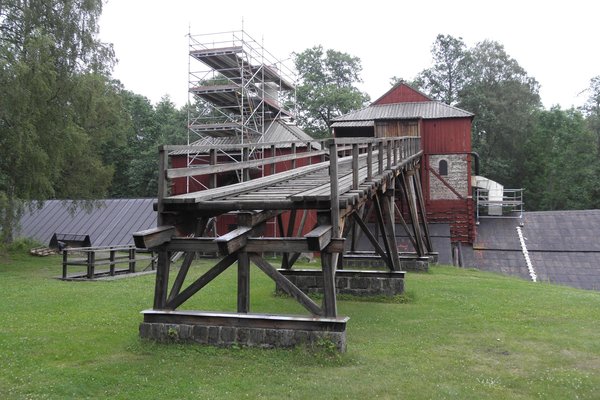Sweden
Engelsberg Ironworks
The Engelsberg Ironworks was one of the most influential industrial complexes in Europe due to its modern machinery and construction.
Sweden was the economic leader in the field of iron from the 17th-19th centuries, and the Engelsberg Ironworks produced a number of technological innovations. Its furnace was powered by waterwheels. After it closed down in 1919, most of the 50 technical and related administrative buildings have been preserved.
Community Perspective: as a very early industrial monument, “they do not give an ‘industrial impression’” – thanks to the idyllic location in the midst of a Swedish forest. The grounds are free to explore; guided tours that let you into the buildings are only available in summer.
Site Info
Official Information
- Full Name
- Engelsberg Ironworks (ID: 556)
- Country
- Sweden
- Status
-
Inscribed 1993
Site history
History of Engelsberg Ironworks
- 1993: Inscribed
- Inscribed
- 1991: Referred
- Bureau - pending completion of a study by ICOMOS of the industrial heritage
- Type
- Cultural
- Criteria
- iv
Links
- UNESCO
- whc.unesco.org
- Official
-
- engelsberg.se — Engelsbergs bruk
All Links
UNESCO.org
- whc.unesco.org — whc.unesco.org/
Official Website
- engelsberg.se — Engelsbergs bruk
Community Information
- Community Category
- Secular structure: Factories and industry
Travel Information
Stockholm hotspot
Recent Connections
-
Falun Red
-
Company town
Angelsberg, Sweden -
In private ownership
owned by Nordstjernan Forvaltnings AB (…
Connections of Engelsberg Ironworks
- Trivia
-
-
In private ownership
owned by Nordstjernan Forvaltnings AB (AB ev) -
Built or owned by Germans
Mining here started by a German miner
-
- Architecture
- World Heritage Process
-
-
Inscribed on a single criterion only
iv. to be an outstanding example of a type of building, architectural or technological ensemble or landscape which illustrates (a) significant stage(s) in human history
-
- Human Activity
-
-
Iron production
-
Breweries
-
Company town
Angelsberg, Sweden
-
- Constructions
-
-
Water Mills
"The introduction of the waterwheel for powering the blast furnace, bellows, and forge to refine iron ore led to the rapid development of the Swedish iron industry." (OUV). See pictures)
-
Falun Red
-
Horse Stables
-
- Timeline
-
-
Built in the 18th century
The main "Manor House" building was constructed around 1750 and the Smelting House in 1778-9. Most of the other buildings date through the 19th century to 1917-18
-
- WHS Hotspots
-
-
Stockholm hotspot
About 2h45 by train / on foot
-
- Visiting conditions
- WHS Names
-
-
Named after individual people
"The works gets its name from Englika, a homesteader of German origin, who came here in the 14th century"See www.ekomuseum.se
-
News
No news.
Recent Visitors
Visitors of Engelsberg Ironworks
- Alexander Barabanov
- Alexander Lehmann
- Alvin
- Argo
- Atila Ege
- Bamse
- Bin
- Birgitte Sørensen
- Brendan Carroll
- Cezar Grozavu
- Cheryl
- Christer Sundberg
- christof
- Claire Bradshaw
- Clyde
- Daniel Chazad
- Dan Pettigrew
- Dimitar Krastev
- Els Slots
- Erik Jelinek
- Errol Neo
- Eva Kisgyorgy
- Farinelli
- Femke Roos
- Frederik Dawson
- Gary Arndt
- George Gdanski
- GeorgeIng61
- Gernot
- Hadrianus
- Harry Mitsidis
- henrik_hannfors
- Iain Jackson
- Ian Cade
- Ingemar Eriksson
- Ivan Rucek
- Jana and Matt
- Jarek Pokrzywnicki
- Jeanne OGrady
- Joel on the Road
- jonas
- Jonas Hagung
- Jonas Kremer
- Jonas Martinsson
- Juha Sjoeblom
- KarenBMoore
- Kbecq
- Klaus Freisinger
- Laurey
- Loic Pedras
- Luboang
- Luis Filipe Gaspar
- Maciej Gil
- Martin
- Martina Rúčková
- MH
- Michael Ayers
- Mikko
- Milan Jirasek
- MMM
- nan
- Nick M
- Nihal Ege
- Olli-Pekka Turunen
- PabloNorte
- Patrik
- Peter Lööv
- Philipp Leu
- Philipp Peterer
- Piotr Wasil
- Randi Thomsen
- Roger Enarsson
- Roger Ourset
- Roman Bruehwiler
- Roman Raab
- Schnitzel
- Sergio Arjona
- Shandos Cleaver
- Solivagant
- Stanislaw Warwas
- Svein Elias
- Szucs Tamas
- Taotao Chen
- Thomas Buechler
- Thomas van der Walt
- Tom Flaten
- triath
- Tsunami
- Vanessa Buechler
- WalGra
- Walter
- Wojciech Fedoruk
- Wo_ko
- YaroMir
- Zoë Sheng
Community Reviews
Show full reviews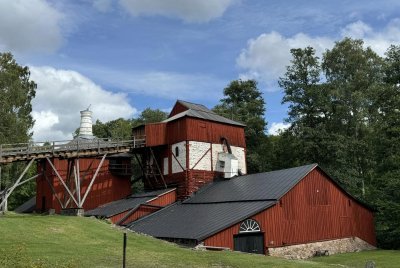
One of the foundations of Sweden's prosperity in the "Age of Greatness" was iron.Miraculously, one of the artifacts of this industry has been preserved, the ironworks in the village of Engelsberg. Fortunately, it's quite easy to get here by train.
Earlier, in the 18th century, there were several factories here, as the location is convenient: iron ore, rivers and forest are nearby. But only this factory has survived, and that is due to the efforts of the owners, who decided to preserve it as a heritage. To this day, the factory and all the surrounding land belong to the Johnson family, one of the richest in Sweden. Therefore, there are some restrictions on the territory, since it is private property.Most tourists limit themselves to inspecting the building from the outside, but I booked a place on an guided tour, and it turned out that I was the only person, so I was given a private tour. The guide from local museum not only showed me the furnaces and water wheels, but also told in detail how the factory functioned. However, I didn't understand much, I'm a typical humanitarian, and all these processes of iron smelting remind me of magic.From what I understood, the ore was delivered from the surrounding area, first by sledges, then a narrow gauge was laid. The ore was first weighed, then ground into small pieces, which were thrown into the blast furnace from above. Water wheels were used to grind ore, and the furnace was …
Keep reading 0 comments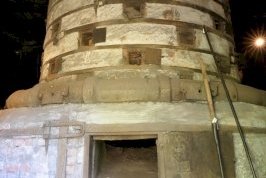
Although this site already received a number of reviews, we will add another since it seems that none of the reviewers managed to get a look at the inside of the buildings.
In high season there are regular guided tours during which the buildings can be visited. In principle the tours are in Swedish, but the (very knowledgeable) guide also made the translation in English for us. The tours are in very small groups but since we visited the site in 2020 / covid times, we don’t know if this is always the case.
First an explanation of the history of the site (and the Swedish ironworks in general) is provided: the iron industry is what fueled Sweden’s development and power as from the 17th century. As mentioned by other reviewers, Engelsberg is located in the beautiful Västmanland province but the guide explained that during this period of iron production the place must have looked like hell (pollution, stench, clouds of smoke, …).
Afterwards, the smelting house – the building appearing on most pictures of Engelsberg – is visited. This structure actually consists of two parts: the roasting furnace (cf. picture) and the blast furnace. This last room also houses an ore crusher powered by a (still functioning) water wheel and a number of panels explaining the iron production. The second building which can be visited is the forge, located at the back of the site next to a lake and also powered by water wheels.
…
Keep reading 0 comments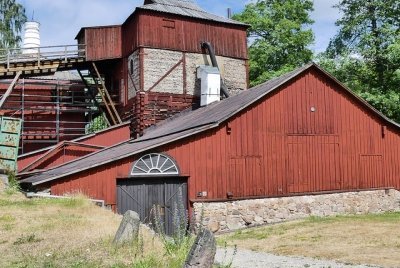
I visited this WHS in June 2018. Apart from the falun red earth-and-timber furnace with engraved milestones (photo), the other components of this WHS are quite similar to the agricultural and idyllic setting of the decorated farmhouses of Halsingland rather than part of an industrial landscape.
The ironmaking traditions of the Norberg mining district go back to the Middle Ages even though iron had been worked at Engelsberg since prehistoric times. In summer, guided tours can be pre-arranged everyday by contacting the tourist office in Fagersta, but make sure to have some kroners as only cash is accepted (very rare in Sweden!). The area can be easily visited for free without a guide by following the numerous information boards. To me, the highlight of this WHS was the area around the manor house with the clock tower, two ornamental slag-stone towers and the nearby forge powered by waterwheels.
Opposite the ferry point to the world's oldest preserved oil refinery on Oil Island, make sure to visit Nya Serveringen, an excellent place to have some shrimp skagen and freshly baked pastries. All in all, the WHS in Engelsberg was a worthwhile picnic stop en route to Falun.
Keep reading 0 comments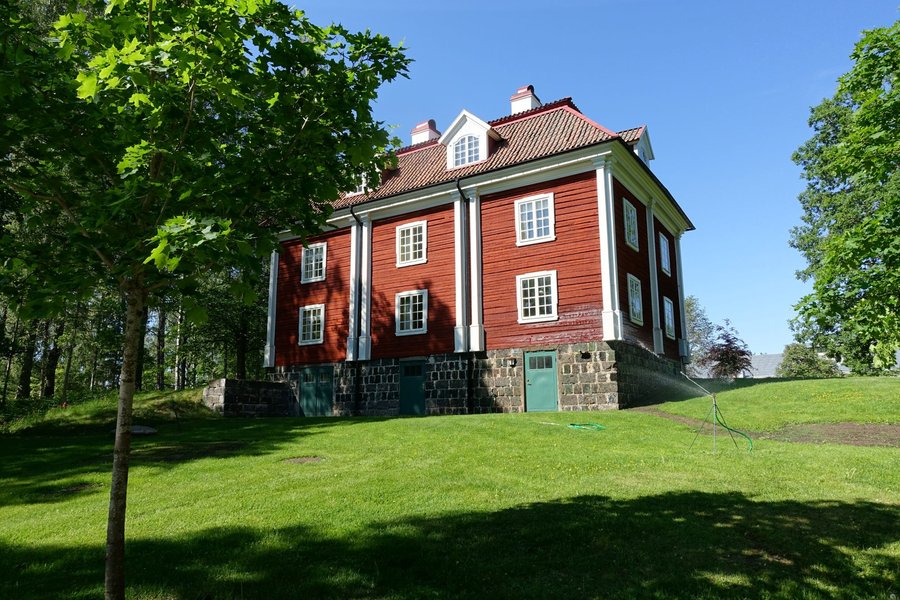
As previous reviewers have pointed out Engelsberg doesn't feel all that industrial for an ironwork. Embedded into the typical Swedish landscape with lakes and forests, it has more the feel of a large picturesque agricultural estate. And in a way it was precisely that as the surrounding forests and lakes were key resources used in processing the iron ore. I felt reminded of Ironbridge Gorge. This is what it must have looked like before the English moved from charcoal to coke.
The site was operated well into the 20th century. It's interesting to consider how long these types of production techniques were competitive.
To me the site could well be extended into a cultural landscape. The Fagersta region to this date remains a center of iron production in Sweden. Several relevant sites are grouped into the Ekomuseum Bergslagen. These could provide some more context and background on Engelsberg.
Getting In
As is the case all over Sweden, high season is from mid-June to mid-August. In this period there are regular guided tours and the visitor center is open. Outside this period you can contact the visitor center to arrange a tour for you. My hunch is, though, that it will be mostly closed and you are left to your own devices. Note that near the train station there is also a tourist information with potentially more generous opening hours.
Exploring the site on your own is not much of a problem, though, as you can roam the …
Keep reading 0 comments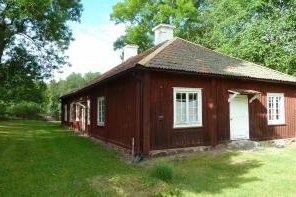
As with others my main memory of this site was how idyllic it looks now, this may stand as an obstacle to understanding its industrial past but it does make for a rather enjoyable stop over.
A bit of a navigational glitch (I got us lost) meant we arrived just as the doors to the little museum closed, as such we had to make do with strolling around the well preserved wooden buildings. The main ironworks were impressive but I could only really guess at how it functioned. Initially I thought that this was the limit of the site however it was pretty clear that there was more too it. The immaculately preserved collection of workers houses and storage buildings proved to be a wonderful place to wander around on a bright Northern European night. The babbling water drew us towards the forge and also allowed us to watch the impressive bird life in the abundant trees.
All in all it was a lovely place to visit, it was tough to get a grasp of the industrial importance of the site, but perhaps the museum and guided tours could address this.
Site 4: Experience 6
Keep reading 0 comments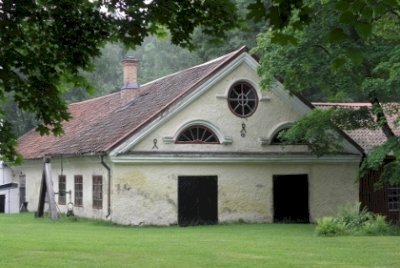
This is really a small site, in a remote corner of a landscape of lakes and forests, dotted here and there with more early industrial remains. One can enter the site freely, there's no entrance fee. In about 5 minutes I thought I had seen it all. The most impressive sight is the big furnace, that's the large red building that you see in every photo of this WHS.
At 10 a.m. the small cafe/shop on-site opened, and I went in to pick up an audio guide. This is a service to non-Swedish speakers, as tours are only given in Swedish. You then can tag along with the Swedish guide, which is the only chance to see something of the interior. I was too early for a tour however, and did my walking tour alone.
At the other end of the complex lie some other interesting buildings including the smelting house. It's a pleasant walk out there, and I liked that so many parts of the early industrial complex have survived.
Keep reading 0 comments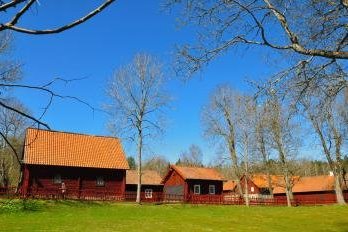
After almost 2 hours on the train from Stockholm, I was in the town of Ängelsberg next to the idyllic Åmänningen Lake, this small town was very pretty with many cute wooden houses, hard to believe that I did not came for summer vacation, but to see industrial site – the Engelsbergs Ironworks. From the train station, it was a really nice 1.5 Kilometers Walk to the complex, passed cute sculpture park and a big tree house along the small lake. The complex of former ironwork mill, the World Heritage Sites, was located well in the middle of the forest, so lovely that may misunderstand to typical farming village.
Almost every building was painted in red or black, a great contrast to very bright green forest under the blue sky of spring. The biggest building was the former iron smelting building; from outside it was looked like a big farmhouse for livestock, a good example of early industrial architectural style which still based on agricultural building type. Behind the Smelting building was the large complex of worker village built in the different styles depend on construction periods. The village was lovely with great surroundings, I was not sure that the beauty landscape was an original or not, if it was, this place may be one of the most beautiful factories I’ve see. The complex had everything for workers including brewery! My friend whose great grandfather, migrated from Wallonia, was once worked in Engelsberg even said that he hard to …
Keep reading 0 comments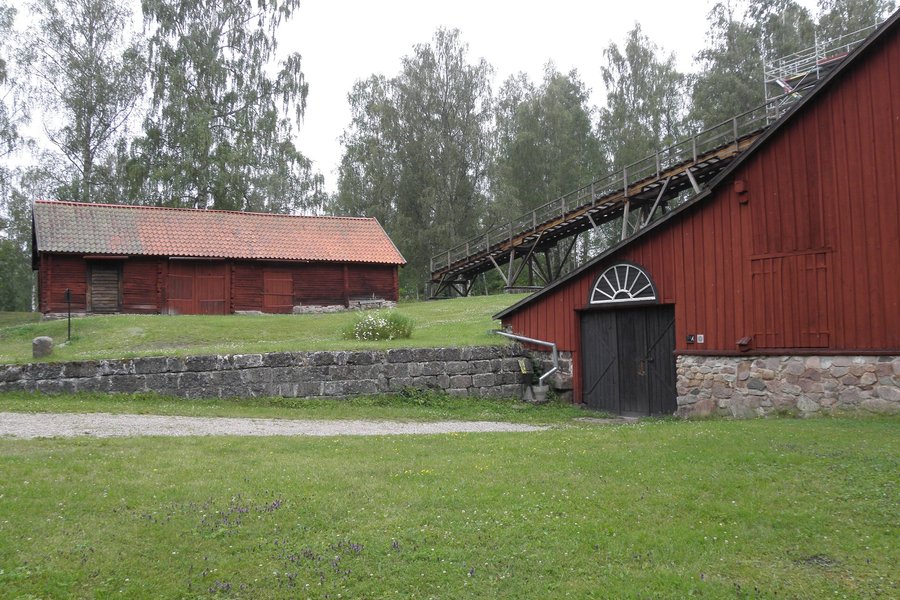
This is a very unusual site - a major ironworks and one of the first industrial production sites in the world, yet it has a pretty idyllic location in the midst of a Swedish forest. Everything here is perfectly preserved, and there are guided tours (with English audioguides) to show you around. The complex of Engelsberg Bruk (also spelled "Ängelsberg" locally) not only includes the industrial buildings used for iron making, but also workers' residences and the manor of the owner's family. Visiting the site by public transport is a bit tricky, but manageable - Ängelsberg is on the regional train line between Västeras and Ludvika (with connections to Falun). From the station it is about a 25-minute walk to the site (the local tourist office is located along the way, and the staff there were friendly enough to let me store my suitcase there).
Keep reading 0 comments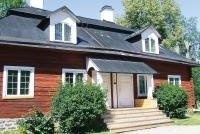
The peaceful shady ambience if this site belies the noise and smells of the site that must have pervaded the area when the ironworks was in operation.
I reached Angelsberg by train from Falun while on the way to Stockholm. The friendly staff at the tourist office (in the station building) gladly looked after my luggage while I walked up the road to the site through an outdoor sculpture park.
Keep reading 0 comments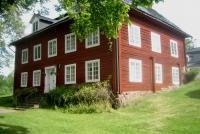
Three hours on a train from Sweden’s capital Stockholm and you find yourself in an area where the iron making traditions goes well back to the Middle Ages. Iron, copper, silver and gold mining together with the forest industry – two industries working closely together - has formed the back-bone of the Swedish economy and rise to power ever since the 16th century. It was back then, when skilled miners came from central Europe to the cold north, seeking their fortunes in the depth of the Scandinavian wilderness. And indeed some of them did.
At Engelsberg it all started with a German immigrant, the miner Englika, who settled here by the end of the 14th century. In 1681 an industrial site for iron works was established and during the 18th and 19th century it developed into the most modern iron works of its time. A mansion was added together with workers homes, offices and other buildings. Engelsberg is also the only ironworks in Sweden that has preserved most of the original equipment. All operation ceased in 1919.
On a small island in lake Åmänningen, just a kilometre away from Engelsbergs Ironworks, you will find another interesting industrial heritage, the Oil Island - the world’s oldest preserved oil refinery. Though it does not belong to the World Heritage Site of Engelsberg – it is still an interesting place to visit. Guided tours are available on both sites during summer months.
Keep reading 0 comments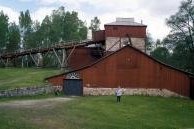
Engelsberg Ironworks are a very early industrial monument – a WHS category of which there are in my opinion too few representatives. ”. Made primarily of wood they do not give an “industrial impression” being set in green and wooded country in what is now a “country park”. Nearby lies the Manor house. They originally dated from c1680 but the preserved buildings are as at 1870.Unfortunately when we were there on a weekday in early June the buildings were not open – but there was plenty to see just wandering around:- A range of production buildings including a Blast Furnace and a Mill together with offices, shops and workers accommodation. . Perhaps it is all a bit too idyllic now and difficult to capture the atmosphere of smoke, fumes and backbreaking work which must have the case. Nevertheless – well worth a detour! Nearby are the remains of primitive Iron age furnaces and some plants of the contemporary Swedish steel industry providing an interesting example of continuity of human activity based on local natural resources.
Keep reading 0 comments
